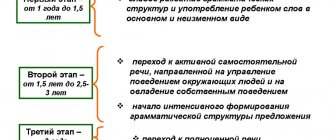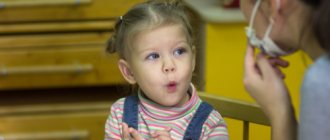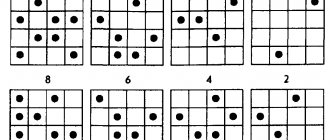Speech disorders in children are a group of disorders of the speech apparatus that have an extremely negative impact on the overall development of the psyche and lead to impairments in writing and reading. The primary intelligence of a child with speech pathology is, as a rule, preserved; he understands speech addressed to him, but cannot communicate normally with others himself. In such cases, it is necessary to promptly begin treatment with a professional speech therapist. Competent therapy can completely correct speech disorders and minimize the complications associated with them.
Types of speech disorders in children
Major speech disorders:
- Alalia is a complete absence or severe underdevelopment of speech. It occurs due to damage to the speech centers of the brain, which occurred in utero or in the first 3 years of a child’s life. In case of underdevelopment of speech, there is a late onset of conversation, poor vocabulary, difficulties in constructing sentences, and a violation of phonemic processes.
- Rhinolalia is a disorder of voice formation and articulation, which is caused by pathology of the structure and functioning of the speech apparatus. Symptoms include: problems with vocabulary and speech grammar, distortions in sound pronunciation, problems with written speech, and disruption of phonemic processes.
- Aphasia is a pathology of the formation, reproduction or perception of speech. The child loses the ability to understand other people's speech or use his own. At the same time, the hearing organs and muscles of the articulatory apparatus are intact. The disorder occurs due to organic damage to the centers of perception or speech formation.
- Dysarthria is a disorder in the pronunciation of individual words, sounds or syllables. Caused by pathology of the muscles involved in the act of speech and the central part of the speech motor analyzer. Dysarthria includes problems with sound pronunciation, speech breathing, and speech motor skills.
- Stuttering is a spasm of the laryngeal and articulatory muscles, due to which the child lingers on any sound and often repeats sounds, syllables, and words. Speech can completely stop at the moment of stuttering or break the smoothness of the conversation and its rhythm.
Peculiarities of mental development of children with speech pathology (general speech underdevelopment)
Introduction.
Speech is a complex functional system, which is based on the sign system of language in the process of communication. The speech functional system is based on the activity of many brain structures, each of which performs its own specific operation.
Children with speech impairments are children who have deviations in speech development with normal hearing and intact intelligence. Speech disorders are diverse; they can manifest themselves in impaired pronunciation, grammatical structure of speech, poor vocabulary, as well as impaired tempo and fluency of speech.
Currently, the requirements for the speech development of children have increased significantly; in the process of education, they must achieve a certain level of development of speech activity, vocabulary, and grammatical structure of speech.
As studies by L.S. Vygotsky have shown. A.R. Luria, A.K. Markova and other authors, the possibilities for speech development are especially great in older preschool age.
In normally developing children, by the beginning of the school period, speech is separated from direct practical experience, and it acquires new functions. However, not all children of this age master new types of speech activity equally easily.
Features of the mental development of children with speech pathology represent a very interesting problem, since the child’s psyche is directly related to his speech function.
Purpose: to study the characteristics of the mental development of children with speech pathology (general speech underdevelopment).
Speech disorders are characterized by the following features: they do not correspond to the age of the speaker, are associated with deviations in the functioning of the psychophysiological mechanisms of speech, are stable in nature, do not disappear on their own, but are fixed, require a certain speech therapy intervention depending on their nature, often have a negative impact on the further mental development of the child .
For normal speech development of a child, communication must be meaningful, take place against an emotionally positive background and encourage him to respond. It is not enough for him to simply hear sounds; first of all, he needs direct communication with an adult on the basis of the leading form of activity characteristic of a given age stage.
Main part.
Any general or neuropsychiatric disease in the first years of life is accompanied by impaired speech development. Therefore, defects of formation and defects of formed speech are distinguished, considering 3 years of age as their conditional division.
Speech formation is one of the main characteristics of a child’s overall development. Normally developing children have good abilities to master their native language. Speech becomes an important means of communication between the child and the world around him, the most perfect form of communication inherent only to humans. But since speech is a special higher mental function provided by the brain, any deviations in its development should be noticed in time. For normal speech formation, it is necessary that the cerebral cortex reaches a certain maturity, the articulatory apparatus is formed, and hearing is preserved. Another indispensable condition is a complete speech environment from the first days of a child’s life.
The reasons for the delay in speech development may be pathology during pregnancy and childbirth, dysfunction of the articulatory apparatus, damage to the organ of hearing, a general lag in the mental development of the child, the influence of heredity and unfavorable social factors (insufficient communication and education). Difficulties in mastering speech are also typical for children with signs of retarded physical development, those who suffered serious illnesses at an early age, those who are weakened, or those who receive malnutrition.
Diagnosis of speech development disorders requires the participation of not only doctors, but also speech therapists, psychologists, and special education specialists in helping the child. To date, no unified classification of speech disorders in children has been developed. Depending on the leading disorders underlying speech disorders in children, L. O. Badalyan proposed the following classification:
I. Speech disorders associated with organic damage to the central nervous system (CNS). Depending on the level of damage to the speech system, they are divided into the following forms.
Aphasia is the collapse of all components of speech as a result of damage to the cortical speech areas.
Alalia is a systemic underdevelopment of speech as a result of damage to the cortical speech zones in the pre-speech period.
Dysarthria is a violation of the sound pronunciation side of speech as a result of a violation of the innervation of the speech muscles. Depending on the location of the lesion, several variants of dysarthria are distinguished: pseudobulbar, bulbar, subcortical, cerebellar.
II. Speech disorders associated with functional changes in the central nervous system (stuttering, mutism and surdomutism).
III. Speech disorders associated with defects in the structure of the articulatory apparatus (mechanical dyslalia, rhinolalia).
IV. Delays in speech development of various origins (prematurity, severe diseases of internal organs, pedagogical neglect, etc.).
In domestic speech therapy, two classifications of speech disorders are used: clinical-pedagogical and psychological-pedagogical (L. S. Volkova, S. N. Shakhovskaya et al., 1999). These classifications, although they consider the same phenomena from different points of view, do not contradict, but complement one another and are focused on solving different problems of a single, but multifaceted process of correction of speech development disorders. It should be noted that both classifications relate to primary speech underdevelopment in children, i.e. to those cases when speech development disorders are observed with intact hearing and normal intelligence.
The clinical and pedagogical classification is based on the principle “from general to specific”, focused on detailing the types and forms of speech disorders, developing a differentiated approach to overcoming them (L. S. Volkova, S. N. Shakhovskaya et al., 1999). Disorders of the development of oral speech are divided into two types: phonation (external) design of the utterance, which are called disorders of the pronunciation side of speech, and structural-semantic (internal) design of the utterance.
Violations of phonation registration of utterances include:
Dysphonia (aphonia) is a disorder (or absence) of phonation due to pathological changes in the vocal apparatus; Dysphonia manifests itself in disturbances in the strength, pitch and timbre of the voice.
Bradylalia is a pathologically slow rate of speech, manifested in the slow implementation of the articulatory speech program.
Tahilalia is a pathologically accelerated rate of speech, manifested in the accelerated implementation of the articulatory speech program.
Stuttering is a violation of the tempo-rhythmic organization of speech, caused by the convulsive state of the muscles of the speech apparatus.
Dyslalia is a violation of sound pronunciation with normal hearing and intact innervation of the speech apparatus (synonyms: sound pronunciation defects, phonetic defects, phoneme pronunciation defects).
Rhinolalia is a violation of voice timbre and sound pronunciation caused by anatomical and physiological defects of the speech apparatus. With rhinolalia, distorted pronunciation of all speech sounds is observed, and not individual ones, as with dyslalia.
Dysarthria is a violation of the sound pronunciation side of speech, caused by organic damage to the central nervous system and disorders of the innervation of the speech apparatus.
Violations of the structural-semantic (internal) design of a statement include two subtypes.
Alalia is the absence or underdevelopment of speech due to damage to the speech areas of the cerebral cortex in the prenatal or early (pre-speech) period of a child’s development (synonyms: dysphasia, early childhood aphasia, developmental dysphasia).
Aphasia is a complete or partial loss of speech caused by local lesions of the speech areas of the cerebral cortex (as a result of traumatic brain injury, cerebrovascular accidents, neuroinfections and other diseases accompanied by damage to the central nervous system).
The psychological and pedagogical classification (L. S. Volkova, S. N. Shakhovskaya et al., 1999) is built on the opposite principle - “from the particular to the general.” This approach is focused on speech therapy intervention as a pedagogical process, the development of speech therapy correction methods for working with a group of children (study group, class). For this purpose, the general manifestations of various forms of speech disorders are determined. In accordance with this classification, speech disorders are divided into two groups: impairment of means of communication and impairments in the use of means of communication. Communication disorders include phonetic-phonemic underdevelopment and general speech underdevelopment (GSD).
Phonetic-phonemic underdevelopment of speech is a violation of the processes of formation of the pronunciation system of the native language in children with various speech disorders due to defects in the perception and pronunciation of phonemes.
Speech activity, associated with the development and functioning of the psyche, plays a large role in the individual development of the child. The level of speech development in children determines the possibilities of their intellectual activity. The main impact of disorders of the speech functional system on the mental development of a child is a decrease in susceptibility to verbal information, which secondarily leads to a violation of general speech development and interferes with the formation of concepts.
Disturbances in speech and motor development are the most common deviations in the formation of higher mental activity in a child. Early detection and correction of various disorders in the development of speech and motor skills of a baby from the first months of life make it possible not only to correct existing deviations, but also to prevent the appearance of further ones, and to achieve a higher level of development of the child. Properly organized early correction can prevent the appearance of secondary developmental deviations.
The motor and speech functions of a child, as well as other higher mental functions, are not given to him initially; they cover a long path, starting from the prenatal period. This path is individual and uneven. At a certain period, all processes are synchronized in order to create together an integral ensemble of speech activity, capable of adequately responding to the demands that the social environment places on the child.
Deviations in speech are not diseases in themselves, they are consequences of diseases and very serious ones. These may be disorders of the brain, the central nervous system (central nervous system), and often the causes are genetic or mental disorders. Long-term observations show that such deviations can be the result of problems in the intrauterine development of the fetus, premature birth, and other non-standard birth situations: rapid or prolonged labor, fetal asphyxia, birth injuries. Among other things, the cause may be hydrocephalus, increased intracranial pressure, mental illness, genetic predisposition, and even early weaning or transfer to artificial feeding. In the first three years, the presence of severe childhood illnesses, injuries due to frequent falls, especially cranial injuries, decreased hearing - all this can become an impetus for the development of delays in speech development. The conditions in which the child grows up, both biological and social, also make a significant contribution. Adverse effects damage those areas of the brain whose development is most intensive at a given time. Research shows that children of drinking parents suffering from mental disorders in families with frequent conflicts suffer from mental disorders and mental disorders. Such delays are typical for children with hyperactivity syndrome, childhood autism, cerebral palsy, and Down syndrome. Regardless of the initial reasons that led to brain damage, the result is the same - certain areas of the brain begin to work incorrectly or inactively. It is easy to understand that children with delayed psycho-speech development have damaged areas responsible for speech, intellectual and mental abilities. However, this is still not a death sentence, and in many cases, timely seeking help can fix everything. Negative social factors themselves do not have a pathological effect on the child, but are reflected in mental development, and the child’s psychology suffers. Therefore, problems with speech development often occur in twins and twins, children who grow up in a poor language environment or simply in bilingual families. The hereditary factor certainly plays a significant role. Unfortunately, it is a very common phenomenon that until the age of 5, mothers do not realize their child’s lack of speech, justifying their actions with stories about relatives who were silent for a long time in childhood, and at the age of 4 began to speak, and immediately in phrases and sentences, and grew up to be normal people. Often an illogical calm is instilled by the elders in the family; cinema also makes its contribution. However, this irresponsible position can lead to irreparable consequences.
In the formation of higher mental functions in a child as an individual, speech plays an exceptional, incomparable role. Performing the function of communication between a child and an adult, it is the basis for the development of thinking; provides the opportunity to plan and regulate the child’s behavior, organize his entire mental life, and influences the development of the personality as a whole.
In some cases, children with various forms of speech disorders have certain psychological (psychological-pedagogical, pathopsychological) characteristics, and the uniqueness of personality formation is noted. This manifests itself to varying degrees in the sensory, intellectual, affective-volitional spheres. It is an indisputable fact that speech disorders to a certain extent influence the formation of other aspects of the psyche, and in some cases are caused by them.
The formation of speech underdevelopment can be influenced by lack of education, low level of communication, unfavorable influence of parents towards existing speech defects and late access to specialists for help. When speech development is delayed, the defects do not have a pronounced specificity, which is characteristic of general speech underdevelopment. Children often make mistakes when inflecting nouns in the genitive plural (cars, balls). Their vocabulary is severely limited, and they make mistakes typical of young children. The speech of children with general speech underdevelopment does not lose its communicative function and allows them to communicate relatively freely. Preservation of this function contributes to the development of insufficient speech skills by school age.
From the point of view of the relationship between speech and mental development, it is also important what role speech deficiencies play in the fate of the child and in his educational activities. There are speech deficiencies that do not have any pronounced effect on the acquisition of school knowledge. These are, for example, many deficiencies in pronunciation, in which the ability to master literacy is fully preserved, there is a complete vocabulary and detailed, grammatically correct speech.
However, there are speech disorders that make it impossible to master school knowledge in normal learning conditions without special help. These are, for example, deficiencies in pronunciation, accompanied by underdevelopment of sound analysis. Children suffering from such violations of pronunciation and sound analysis have great difficulties in mastering reading and writing, which in many cases leads to failure in the Russian language.
Various forms of general speech underdevelopment hinder the successful acquisition of school knowledge even more. Characteristics of general speech underdevelopment are a limited vocabulary, agrammatism, and a violation of the sound composition of words. The lexico-grammatical and phonetic development of children suffering from alalia and aphasia, for example, turns out to be insufficient for mastering program material. When these children enter a mainstream school, they become underachievers. Under normal teaching methods, mastering school knowledge is not possible for them only due to abnormal speech development. Speech deficiencies such as these are in themselves a serious obstacle to the normal acquisition of basic knowledge. Thus, the analysis of abnormal speech development should include consideration of aspects of mental activity dependent on the state of speech, primarily educational activity, which largely determines the child’s future.
Attaching great importance to the influence of speech defects on the child’s psyche, it is necessary, however, to keep in mind the child’s attitude towards his defect. There are cases where a very limited speech deficiency causes difficult experiences and, as a result, affects the entire behavior and even the general mental development of the child. Thus, due to a lack of pronunciation of one sound, a child may begin to avoid the company of other children, be embarrassed to answer in class, speak at meetings, etc. It is well known that some children who stutter have a severe reaction to their handicap, even with mild stuttering. The opposite is also observed: despite a pronounced speech impairment, the child remains indifferent to his disability. Thus, the role of speech deficiency in the development and fate of a child depends on the nature of the defect, its degree, and also on how the child relates to his defect.
As speech development is corrected, intelligence is restored. Children are catching up with their peers in terms of development. To make an accurate diagnosis, a detailed study of the life history and an extremely careful examination of the child are necessary. When interviewing parents, the anamnesis may not contain information about lesions of the central nervous system. Contains information about the pathology of pregnancy, traumatic birth, the birth of a given child premature or immature, with asphyxia, with a low score on the Angar scale, with the presence of diseases at an early age (frequently ill children).
Conclusion.
The physiological basis of speech is the activity of the second signaling system, the stimulus of which is words. The functioning of the second signaling system is carried out in inextricable interaction with the first. The formation of oral speech occurs as the formation of activity. The most important condition for the formation of oral speech is the development of the child’s motivational side of speech activity. The development of speech is the development of a way of communication. Speech is a tool for the development of the higher parts of the human psyche. The general underdevelopment of speech at the initial stages of development cannot be compensated for later.
The main task of speech development of a preschool child is mastery of the norms and rules of the native language, defined for each age stage, and the development of their communicative abilities
The study showed that in children without speech pathology, compared to children with SLD, there is a significant superiority in such parameters of mental development as auditory attention and auditory-verbal memory.
The overwhelming number of children with speech disorders study in secondary schools. Since pronounced signs of speech disorders at school age may no longer be present, teachers often associate difficulties in teaching such children with shortcomings in upbringing, low parental control, and social neglect. These children require special attention from teachers.
First of all, children who have difficulties in learning and especially in mastering the process of writing and reading should be referred to a speech therapist. In addition, these children need a more favorable (lighter) learning regime. This regime is characterized not by a reduction in the level of requirements for mastering program material, but by the organization of a training regime. They need special psychological support from the teacher. This is expressed in encouragement, a soft tone of comments, encouragement, etc. The tasks that are set for the class as a whole in the educational process for such children should be detailed, instructions should be more detailed, i.e. be easy to understand and implement. In cases where a child has persistent errors in writing and reading, he should not be forced to repeat the same tasks over and over again. In this case, the child needs specialized speech therapy help.
Bibliography.
1. Bolotina L. R. Preschool pedagogy / Komarova T. S. ,Baranov S.P. / Textbook M. 1997-230p.
2.Boryakova N.Yu. Features of the formation of speech utterances in older preschoolers with mental retardation M. 1983-140p.
3. Valitova I.E. psychology of development of a preschool child. Minsk 1997-325s
4. Volkova L. S., Shakhovskaya S. N. Speech therapy. 3rd ed. M.: Vlados, 1999. 678 p.
5.Volkova L.S. A textbook on speech therapy. Impaired children's speech and their aspirations into educational processes. M 1997 -250s.
6. Vygotsky L.S. Selected psychological studies. Thinking and speech. Publishing house A.N. RSFSR 1956 – 440 p.
7. Zhukova N.S. and others. Speech therapy. Overcoming general speech underdevelopment in preschool children - Ekaterinburg ARDLT, 1998-320p.
8.Koltsova M.M. Motor activity and development of functions of the child’s world. M., Pedagogy -210 p.
9.Loginova E.A. Speech pathology. History of study, diagnosis, overcoming. St. Petersburg, 1992 -185 p.
10. Levina R.E. General underdevelopment of speech M.1991-220p.
11. Luria A.R. Language and consciousness (edited by E.D. Chomskaya) M., 1999-398p.
12. Piaget J. Speech and thinking of a child Soyuz St. Petersburg. 1997-390s.
What are the dangers of speech disorders in children?
Speech activity in children is directly related to the development of the psyche and affects the intellectual, sensory, emotional and volitional spheres of life. If it is impossible to communicate normally with peers, a child may develop serious psychological complexes, even a phobia of communication. Such children are characterized by depression, depression, low motivation, frequent changes of interests, uncertainty, irritability, resentment, aggression, and problems with self-control.
Children with speech disorders are also noted to have impaired physical development: lack of coordination of movements, retardation in actions, and general weakening of the body.
Ignoring speech disorders in children is fraught with their complete social isolation.
Norms of psychophysical development
Until the age of 1 year, the baby’s leading activity is emotional communication. Therefore, during this period, the mother must communicate a lot and emotionally with the child. By 2 months, a complex of revival at the appearance of relatives appears: motor reactions and a smile appear. At 6 months, the baby distinguishes his mother from other people.
In addition to emotional communication, adults are involved in the development of the baby’s motor sphere. During this period, his grasping reflex is especially strong. The task of adults is to arouse the child’s interest in performing actions with toys.
In the period from 1 to 3 years, the child’s leading activity is object-manipulative. The baby masters self-care skills, learns to hold a pencil, and cut out simple shapes from paper. The child interacts more actively with people around him. The peculiarity of his communication during this period is the connection with objective activity.
At the age of 3 years, the child begins to recognize himself as an individual and compares himself with others. The baby strives to do everything on his own and asks more questions about the world around him. He already knows how to count (at least up to 3), knows the names of simple geometric shapes, and learns to compare and analyze objects.
By the age of 4, children master more complex differentiated movements of their fingers (fastening buttons, tying shoelaces, etc.). The child interacts more actively with peers, and a social orientation is already evident in communication. The memory capacity increases, so at this age you need to learn poems with him.
Five-year-old children help adults and begin to play role-playing games. At this age you can already stage theatrical performances. By the age of 6-7 years, the child should have a well-developed motor sphere, namely, coordination of movements; he easily navigates in space. During this period, children should be able to evaluate their actions and those around them. Concentration increases; they can remember a fairly large flow of information; become more diligent.
Where to go if your child has speech problems?
Speech disorders require long-term, targeted correction work under the guidance of a speech therapist. It is important to find a qualified specialist who has a wide range of knowledge and techniques for treating speech therapy disorders. With a responsible attitude towards the development of a child’s speech, it is possible to completely adapt him to interaction with society, communication, and learning at school.
Our clinic welcomes a professional speech pathologist with many years of experience, an honorary member of the National Association of Speech Therapists. We will be happy to help your children overcome any difficulties with speech and enjoy full and joyful communication with the outside world.
Norms of speech development
Before moving on to the study of deviations, it is necessary to know the normal development of speech ontogenesis. Parents should pay attention in the first months of their baby’s life to his behavior and any manifestations of verbal reactions. During this period, he interacts with others by screaming. Normally, the cry has a clear sound, quite loud and intonation-colored.
By 2-3 months, humming appears. It consists of vowels and some consonants. A baby can roam alone, but when an adult appears, the humming becomes intonationally colored. This is the first semblance of dialogue between him and other people.
By 6 months, the humming stage is replaced by babbling. The baby begins to pronounce the first syllables, which most parents take for the first words. Babbling words are first spoken briefly and casually. Then the baby babbles more and more often, and babbling chains appear. Such speech is not meaningful, but it becomes the basis for further harmonious speech development.
The first words appear by 1-1.5 years. During this period, it is very important for adults to support their baby in his quest to master the language. By the age of 2, the baby communicates with others in simple phrases, and by the age of 3, his sentences become more and more common.
In the period from 2 to 3 years, there is a sharp increase in vocabulary, so the child begins to more and more actively explore the world around him. People around them better understand children's speech, although the baby has not yet mastered the correct pronunciation of all sounds. Children at this age also experience disturbances in syllable structure because they are just beginning to master the pronunciation of difficult and long words.
By the age of 4, the pronunciation of all sounds should be formed, with the exception of the sonorant group. The child communicates in common sentences and more often uses possessive adjectives and pronouns in his speech. Simple grammatical categories are being mastered, he coordinates words in a sentence, and forms new ones using the suffix method. At this age, no disturbances in syllable structure are observed.
By the age of 5-6 years, children master the pronunciation of sonorant sounds. They already know how to make logical chains, learn to give arguments, compare and analyze the properties of objects. Speech becomes more and more expressive, children learn to control their voice. They can retell short stories and write a short story on their own or with a little help from adults.
By the age of 6-7, children’s speech is practically no different from the conversation of an adult. The child actively uses adverbs and numerals. Makes sentences using prepositions and conjunctions. The assimilation of descriptive stories also occurs. During this period, children begin to be prepared for school so that they fully master the phonetic and grammatical components of their native language.
Disturbances in the development of speech in preschool children.
The following are the main causes of speech impairment:
- Heredity;
- Damage to the fetal brain during pregnancy and complicated labor;
- Disruption of the articulatory apparatus;
- Delayed mental and physical development;
- Damage to the hearing organs;
- Social factor (lack of verbal communication between parents and child);
- Severe forms of the disease at an early age;
- Lack of adequate nutrition.
Speech therapist, psychologist and teacher - the qualified assistance of these specialists is indispensable in solving problems related to the developmental characteristics of children with speech disorders.








